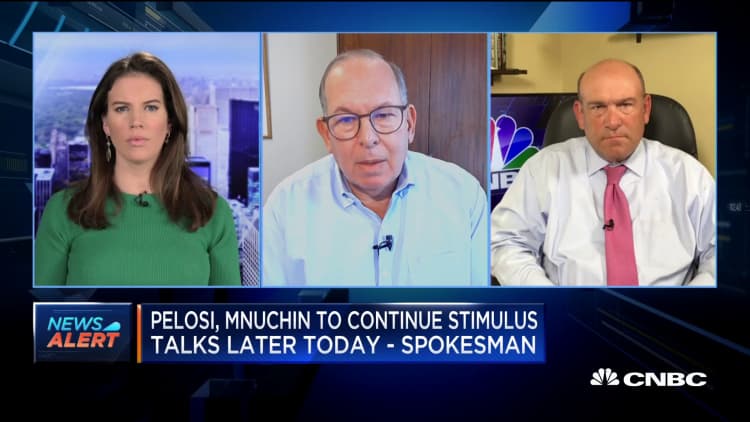As workers who were brought back to their jobs after furloughs and layoffs due to the Covid-19 crisis face additional rounds of cuts, many may be wondering if it's possible to restart unemployment benefits.
For most, the answer is yes.
In August and September, 27% of workers who were put back on payrolls after an initial Covid-19-related layoff lost their jobs again, according to a joint study from Cornell University, the U.S. Private Sector Job Quality Index and research firm RIWI that was released Wednesday. Another 36% have been told by their employers that they could be laid off again as the coronavirus pandemic continues, according to the study.
The number of Americans claiming unemployment insurance benefits spiked to a record high in March as sweeping shelter-in-place orders to curb the disease shutdown much of the U.S.
Initial claims for unemployment insurance have since decreased but remain elevated compared to pre-pandemic levels, as businesses struggle even as the country reopens. About 26 million American adults were collecting unemployment benefits in all state programs as of Sept. 12, according to data released Thursday.

How to restart benefits
The process for restarting unemployment insurance is generally simple. Workers that have already been laid off and collected unemployment because of the pandemic have generally established a benefit year, or 52-week period from the first claim filed.
"Once you establish a benefit year, and maybe go back to work for a little while but get laid off again, you can just go ahead and reopen your old claim," if you haven't previously exhausted allotted benefits, said Michele Evermore, a senior policy analyst at the National Employment Law Project.
More from Invest in You:
How big companies like Walmart try to recruit more teenage workers
Experts say 'money disorders' may be to blame for rise in personal debt
How much money do you need to retire? Start with $1.7 million
One thing that people shouldn't do if they're laid off again is file another initial claim for unemployment insurance, according to Evermore.
"That's not necessary and it's not a good idea," she said. Filing another initial claim will confuse the system and could mean that you're filing under a lower dollar amount — benefits are generally calculated using an average of quarterly wages over the last year. That might mean you get less in weekly benefits, said Evermore.
Additional unemployment insurance programs
State benefits last for 26 weeks, meaning that if a worker spent six weeks on unemployment, they'd have 20 weeks left to claim. But even if a worker has run out of state benefits, the CARES Act put programs in place for them to claim additional unemployment insurance.
"If you were laid off for more than 26 weeks, you'd restart and go into PEUC, probably," said Evermore, referring to the Pandemic Emergency Unemployment Compensation program, which extends state unemployment benefits by up to 13 weeks through the end of the year.
And, most states have special extended benefit programs that are available to workers during times of high unemployment. In a majority of states, these programs extend unemployment for another 13 weeks, though some states differ in length — Florida and North Carolina offer about six weeks, while other states pay up to 20 weeks.

Workers who have exhausted other benefits could also apply for the Pandemic Unemployment Assistance program, which was created to help those that traditionally weren't eligible for state UI, such as independent contractors and gig workers. The PUA program offers 39 weeks of unemployment benefits but requires that people have lost work due to the Covid-19 pandemic.
When benefits may stop
To be sure, there is a limited amount of time for unemployed workers to have access to the extended benefits programs from the CARES Act.
Both PEUC and PUA will expire at the end of the year if the programs are not extended by another stimulus package. So far, Democrats and Republicans have failed to reach an agreement on an additional coronavirus aid bill.
That means that millions of workers will stop receiving benefits in the programs on Dec. 31, regardless of their remaining eligibility.
Once you establish a benefit year, and maybe go back to work for a little while but get laid off again, you can just go ahead and reopen your old claimMichele EvermoreSenior policy analyst at National Employment Law Project
In addition, workers receiving benefits in all programs were eligible for an additional $600 weekly unemployment benefit, which expired in July. In August, President Donald Trump signed an executive order that extended $300 in extra weekly unemployment for some workers, but some states have already run out of funding for the program.
On Thursday, the House passed Democrats' $2.2 trillion coronavirus stimulus bill, which would extend most programs and reinstate the additional $600 weekly unemployment benefit, but the package is unlikely to pass the Republican-controlled Senate and become law.
SIGN UP: Money 101 is an 8-week learning course to financial freedom, delivered weekly to your inbox.
CHECK OUT: 20 smart ways to make money on the side: Some of these gigs can pay more than $100/hr via Grow with Acorns+CNBC.
Disclosure: NBCUniversal and Comcast Ventures are investors in Acorns.






